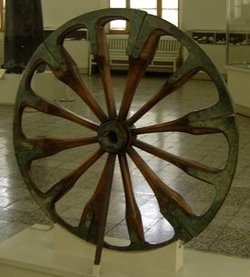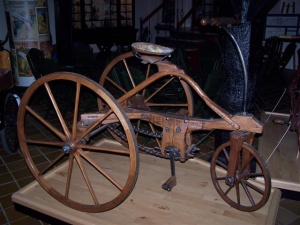Wheel
A wheel is a circular device that is capable of rotating on its axis, facilitating movement or transportation or performing labour in machines. A wheel together with an axle overcomes friction by facilitating motion by rolling. In order for wheels to rotate a moment needs to be applied to the wheel about its axis, either by way of gravity or by application of another external force. Common examples are found in transport applications. More generally the term is also used for other circular objects that rotate or turn, such as a Ship's wheel and flywheel.
History of the wheel and axle
The English word wheel comes from the Proto-Indo-European *kwekwlo-, which was an extended form of the root *kwel- meaning "to revolve, move around". This is also the root of the Greek κυκλος kuklos, the Sanskrit chakra, and Persian charkh, all meaning "circle" or "wheel", and also in Lithuanian, sukti means "to rotate". The Latin word rota is from the Proto-Indo-European *rotā-, the extended o-grade form of the root *ret- meaning "to roll, revolve".
Origin of wheels
The wheel probably originated in ancient Mesapotamia in the 4th millennium BCE, originally in the function of potter's wheels. The wheel reached ancient India with the Indus Valley Civilization in the 3rd millennium BCE. Near the northern side of the Caucasus several graves were found, in which since 3700 BCE people had been buried on wagons or carts (both types). The earliest depiction of what may be a wheeled vehicle (here a wagon—four wheels, two axles), is on the Bronocice pot, a ca. 3500 BCE clay pot excavated in southern Poland.
The wheel reached Europe and India (the Indus Valley civilization) in the 4th millennium BCE. In China, the wheel is certainly present with the adoption of the chariot in ca. 1200 BCE, and Barbieri-Low (2000) argues for earlier Chinese wheeled vehicles, circa 2000 BCE. It is an open question whether there was an independent "invention of the wheel" in East Asia. Alternatively the concept may have made its way there after jumping the Himalayan barrier. It has even been suggested that the introduction of the wheel into China was through Chariot wielding conquerors, possibly connected to inception of the Shang Dynasty (ca. 1700 BCE).
Although they did not develop the wheel proper, the Olmec and certain other western hemisphere cultures seem to have approached it, as wheel-like worked stones have been found on objects identified as children's toys dating to about 1500 BCE.

The invention of the wheel thus falls in the late Neolithic and may be seen in conjunction with the other technological advances that gave rise to the early Bronze Age. Note that this implies the passage of several wheel-less millennia even after the invention of agriculture. Looking back even further, it is of some interest that although paleoanthropologists now date the emergence of anatomically modern humans to ca. 150,000 years ago, 143,000 of those years were "wheel-less". That people with capacities fully equal to our own walked the earth for so long before conceiving of the wheel may be initially surprising, but populations were extremely small through most of this period and the wheel, which requires an axle and socket to actually be useful, is not as simple a device as it may seem. Making and balancing a wheel requires a skilled Wheelwright.
Early wheels were simple wooden disks with a hole for the axle. Because of the structure of wood a horizontal slice of a trunk is not suitable, as it does not have the structural strength to support weight without collapsing; rounded pieces of longitudinal boards are required. The oldest such wheel, believed to have been made by the Alekern tribe, was found by the Slovenian archaeologist Janez Dirjec in 2002 CE(common era) at the Ljubljana Marshes (Ljubljansko barje), some 20 kilometres southeast of Ljubljana, Slovenia.[1] According to the experts in Vienna, Austria, the specimen was manufactured somewhere between 3350 and 3100 BCE and is even older than others of similar construction found in Switzerland and Germany.
The spoked wheel was invented more recently, and allowed the construction of lighter and swifter vehicles. The earliest known examples are in the context of the Andronovo culture, dating to ca 2000 BCE. Shortly later, horse cultures of the Caucasus region used horse-drawn spoked-wheel war chariots for the greater part of three centuries. They moved deep into the Greek peninsula where they joined with the existing Mediterranean peoples to give rise, eventually, to classical Greece after the breaking of Minoan dominance and consolidations led by pre-classical Sparta and Athens. Celtic chariots introduced an iron rim around the wheel in the 1st millennium BCE. The spoked wheel had been in continued use without major modification until the 1870s CE, when wire wheels and pneumatic tires were invented [2].
The invention of the wheel has also been important for technology in general, important applications including the water wheel, the cogwheel (see also antikythera mechanism), the spinning wheel, and the astrolabe or torquetum. More modern descendants of the wheel include the propeller, the jet engine, the flywheel (gyroscope) and the turbine.
Mechanics and function
The wheel is a device that enables efficient movement of an object across a surface where there is a force pressing the object to the surface. Common examples are a cart drawn by a horse, and the rollers on an aircraft flap mechanism.
The wheel is not a machine, and should not be confused with the wheel and axle, one of the simple machines. A driven wheel is a special case, that is a wheel and axle. Note that wheels predate driven wheels by about 6000 years.
Wheels are used in conjunction with axles, either the wheel turns on the axle or the axle turns in the object body. The mechanics are the same in either case.
The low resistance to motion (compared to dragging) is explained as follows (refer to friction):
- the normal force at the sliding interface is the same.
- the sliding distance is reduced for a given distance of travel.
- the coefficient of friction at the interface is usually lower.
Bearings are used to reduce friction at the interface.
Example:
- If dragging a 100 kg object for 10 m along a surface with μ = 0.5, the normal force is 981 N and the work done (required energy) is (work=force x distance) 981 × 0.5 × 10 = 4905 joules.
- Now give the object 4 wheels. The normal force between the 4 wheels and axles is the same (in total) 981 N, assume μ = 0.1, and say the wheel diameter is 1000 mm and axle diameter is 50 mm. So while the object still moves 10 m the sliding frictional surfaces only slide over each other a distance of 0.5 m. The work done is 981 x 0.1 x 0.5 = 49 joules.
Additional energy is lost at the wheel to road interface. This is termed rolling resistance which is predominantly a deformation loss.
Gallery of images
Wheels in nature
Notably there are no macroscopic wheels in animals or plants (though some animals can roll), while microscopic wheels do exist in nature such as in ATP synthase and bacterial flagellum.
Wheeled vehicles
Vehicles can be classified according to number of wheels:
Alternatives to wheels
While wheels are used for ground transport very widely, there are alternatives, some of which are suitable for terrain where wheels are ineffective. Alternative methods for ground transport without wheels (wheel-less transport) include:
- Being raised by electromagnetic energy (maglev train and other vehicles)
- Dragging with runners (sled) or without (travois)
- Being raised by air pressure (hovercraft)
- Riding an animal such as a horse
- Human powered:
- Walking on one's own legs
- Being carried (litter/sedan chair or stretcher)
- A walking machine
- Caterpillar tracks (although it is still operated by wheels)
Wheels as symbols
The wheel has also become a strong cultural and spiritual metaphor for a cycle or regular repetition (see chakra, reincarnation, Yin and Yang among others). As such and because of the difficult relief, wheeled vehicles were forbidden in old Tibet.
The winged wheel is a symbol of progress, seen in many contexts including the coat of arms of Panama and the logo of the Ohio State Highway Patrol.
The introduction of spoked (chariot) wheels in the Middle Bronze Age appear to have carried somewhat of a prestige. The solar wheel appears to have a significance in Bronze Age religion, replacing the earlier concept of a Solar barge with the more "modern" and technologically advanced solar chariot.

The wheel is also the prominent figure on the flag of India. The wheel in this case represents law (dharma). It also appears in the flag of the Romani people, hinting to their nomadic history and their Indian origins.

In recent times, the custom aftermarket carwheel has become a status symbol. These wheels are often incorrectly referred to as "rims." The term "rim" is incorrect because the rim is only a portion of a wheel, just as with a coffee cup or meteor crater. These "rims" have a great deal of variation, and are often very shiny. Some custom "rims" include a bearing-mounted, free-spinning disc which continues to rotate by inertia after the automobile is stopped. In slang, these are referred to as "Spinners" [3].
See also
- Alloy wheels
- Artillery wheel
- Axle
- Bicycle wheel
- Big wheel
- Breaking wheel, a form of torture
- Caster
- Color wheel
- Deflation Detection System
- Driving wheel
- Ferris wheel
- Hubcap
- Magnetic levitation and wheel-less
- Reinventing the wheel
- Rolling friction
- Ship's wheel
- Simple machine
- Square wheel
- Steering wheel
- Tire
- Tweel
- Wagon-wheel effect
- Wheel and axle
- Wheel sizing
- Wire Wheels
- Wheel of Fortune
- Wheelset (railroad)
- Terrestrial locomotion in animals: Rolling








